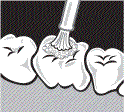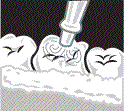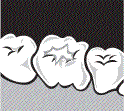


 Porcelain Veneers
Porcelain Veneers Teeth Whitening
Teeth Whitening Bonding
Bonding Tooth Colored Fillings
Tooth Colored Fillings Orthodontics
Orthodontics Gum Contouring
Gum Contouring Fillings
Fillings  On lays and Inlays
On lays and Inlays Crowns and Bridges
Crowns and Bridges Denture
Denture Extractions and Bone Grafts
Extractions and Bone Grafts Dental Implants
Dental Implants Periodic Checkups
Periodic Checkups Scaling and Root Planing
Scaling and Root Planing  Custom Night and Sports Guards
Custom Night and Sports Guards Snoring and Sleep Apnea
Snoring and Sleep Apnea Root Canal Treatment
Root Canal Treatment  Sealants
Sealants  Routine Checkup
Routine Checkup Fluoride Application
Fluoride Application Extractions
Extractions Space Maintainers
Space Maintainers Porcelain Fused Metallic Crown
Porcelain Fused Metallic Crown Dental Counseling
Dental Counseling Smile Makeover
Smile Makeover Neuromuscular Dentistry
Neuromuscular Dentistry Sedation Dentistry
Sedation Dentistry Laser Dentistry
Laser Dentistry Digital Dentistry
Digital Dentistry Relaxation Dentistry
Relaxation Dentistry
Dental Sealants for protecting teeth
Dental sealant is a thin, plastic coating painted on the chewing surfaces of teeth -- usually the back teeth (the premolars and molars) -- to prevent tooth decay. The sealant quickly bonds into the depressions and grooves of the teeth, forming a protective shield over the enamel of each tooth.
Although thorough brushing and flossing can remove food particles and plaque from smooth surfaces of teeth, they cannot always get into all the nooks and crannies of the back teeth to remove the food and plaque. Sealants protect these vulnerable areas from tooth decay by "sealing out" plaque and food.
Who Should Get Sealants?
Because of the likelihood of developing decay in the depressions and grooves of the premolars and molars, children and teenagers are candidates for sealants. However, adults without decay or fillings in their molars can also benefit from sealants.
Typically, children should get sealants on their permanent molars and premolars as soon as these teeth come in. In this way, the sealants can protect the teeth through the cavity-prone years of ages 6 to 14.
In some cases, dental sealants may also be appropriate for baby teeth, such as when a child's baby teeth have deep depressions and grooves. Because baby teeth play such an important role in holding the correct spacing for permanent teeth, it's important to keep these teeth healthy so they are not lost too early.
How Are Sealants Applied?
Applying sealant is a simple and painless process. It takes only a few minutes for your dentist or hygienist to apply the sealant to seal each tooth. The application steps are as follows:
How Long Do Sealants Last?
Sealants can protect teeth from decay for up to 10 years, but they need to be checked for chipping or wearing at regular dental check-ups. Your dentist can replace sealants as necessary.
Does Insurance Cover the Cost of Sealants?
Many insurance companies cover the cost of sealants. Check with your dental insurance carrier to determine if sealants are covered under your plan.
Cavities occur as a result of tooth decay. Tooth decay is the destruction of the tooth structure. Tooth decay can affect both the enamel (the outer coating of the tooth) and the dentin (the inner layer of the tooth).
Tooth decay occurs when foods containing carbohydrates (sugars and starches) such as breads, cereals, milk, soda, fruits, cakes, or candy are left on the teeth. Bacteria that live in the mouth digest these foods, turning them into acids. The bacteria, acid, food debris, and saliva combine to form plaque, which clings to the teeth. The acids in plaque dissolve the enamel surface of the teeth, creating holes in the teeth called cavities, or caries.
The teeth are the hardest substances in the human body. Besides being essential for chewing, the teeth play an important role in speech. Parts of the teeth include:
• Enamel: The hardest, white outer part of the tooth. Enamel is mostly made of calcium phosphate, a rock-hard mineral.
• Dentin: A layer underlying the enamel. Dentin is made of living cells, which secrete a hard mineral substance.
• Pulp: The softer, living inner structure of teeth. Blood vessels and nerves run through the pulp of the teeth.
Many people think cavities only affect children, but changes that occur with aging make cavities an adult problem too. Recession of the gums (a pulling away of gum tissue from the teeth), often associated with an increased incidence of gingivitis (gum disease), can expose tooth roots to plaque. Also, sugary food cravings can make anyone more vulnerable to developing cavities.
Decay can also occur around the edges of fillings in older adults. Because many older adults lacked the benefits of fluoride and modern preventive dental care when they were growing up, they often have a number of dental fillings. Over the years, these fillings may weaken and can fracture, allowing bacteria to accumulate in the tiny crevices causing tooth decay.
Your dentist can discover cavities during your regular dental check-up. The tooth surface feels soft when probed by your dentist with a dental instrument. X-rays can also show cavities between teeth before they become visible to the eye.
In advanced stages of tooth decay, you might experience a toothache, especially after consuming sweet, hot, or cold foods or drinks. Other signs of tooth decay are visible pits or holes in the teeth.
There are a number of different treatments for cavities depending on the extent of tooth decay. If decay is not extensive, the decayed portion of the tooth is removed by drilling and replaced with a filling made of silver alloy, gold, porcelain, or a composite resin. Materials used in fillings are considered safe. Concerns have been raised over the safety of mercury-based, silver amalgams in particular, but the American Dental Association (ADA), FDA, and other public health agencies continue to support the safety of this restorative material. Allergies to silver amalgam are rare as are allergies to other restorative materials.
If the tooth decay is extensive and there is limited tooth structure remaining, crowns will be used. If a crown is needed, the decayed or weakened area of the tooth is removed and repaired and a crown is fitted over the remainder of the tooth. Crowns are made from gold, porcelain, or porcelain fused to metal.
Tooth decay is the destruction of tooth structure and can affect both the enamel (the outer coating of the tooth) and the dentin layer of the tooth.
Tooth decay occurs when foods containing carbohydrates (sugars and starches), such as breads, cereals, milk, soda, fruits, cakes, or candy are left on the teeth. Bacteria that live in the mouth digest these foods, turning them into acids. The bacteria, acid, food debris, and saliva combine to form plaque, which clings to the teeth. The acids in plaque dissolve the enamel surface of the teeth, creating holes in the teeth called cavities.
To prevent tooth decay:
A mouth rinse containing fluoride can help prevent tooth decay, according to the American Dental Association.
Researchers are developing new means to prevent tooth decay. One study found that a chewing gum that contains the sweetener xylitol temporarily retarded the growth of bacteria that cause tooth decay. In addition, several materials that slowly release fluoride over time, which will help prevent further decay, are being explored. These materials would be placed between teeth or in pits and fissures of teeth. Toothpastes and mouth rinses that can reverse and "heal" early cavities are also being studied.
Sealants are thin, plastic coatings painted on the chewing surfaces of the back teeth.
Sealants are put on in dentists' offices, clinics, and sometimes in schools. Getting sealants put on is simple and painless. Sealants are painted on as a liquid and quickly harden to form a shield over the tooth.

1. The tooth is cleaned.
2. The tooth is dried, and cotton is put around the tooth so it stays dry.
3. A solution is put on the tooth that makes the surface a little rough. (It is easier for the sealant to stick to a slightly rough surface.)
4. The tooth is rinsed and dried. Then new cotton is put around the tooth so it stays dry.
5. The sealant is applied in liquid form and hardens in a few seconds.
6. The sealant is in place.
The most important reason for getting sealants is to avoid tooth decay.
Fluoride in toothpaste and in drinking water protects the smooth surfaces of teeth but back teeth need extra protection. Sealants cover the chewing surfaces of the back teeth and keep out germs and food.
Having sealants put on teeth before they decay will also save time and money in the long run by avoiding fillings, crowns, or caps used to fix decayed teeth.
Germs in the mouth use the sugar in food to make acids. Over time, the acids can make a cavity in the tooth.
Of course a healthy tooth is the best tooth. So it is important to prevent decay. That's why sealants are so important.
The chewing surfaces of back teeth are rough and uneven because they have small pits and grooves. Food and germs can get stuck in the pits and grooves and stay there a long time because toothbrush bristles cannot brush them away.
Children should get sealants on their permanent molars as soon as the teeth come in -- before decay attacks the teeth.
The first permanent molars -- called "6 year molars" -- come in between the ages of 5 and 7.
The second permanent molars -- "12 year molars" -- come in when a child is between 11 and 14 years old.
Other teeth with pits and grooves also might need to be sealed.
Teenagers and young adults who are prone to decay may also need sealants.
Your dentist might think it is a good idea, especially if your child's baby teeth have deep pits and grooves.
Baby teeth save space for permanent teeth. It is important to keep baby teeth healthy so they don't fall out early.
Some health insurance programs pay for sealants. Check with your state Medicaid program or
Sealants can last up to 10 years. But they need to be checked at regular dental check-ups to make sure they are not chipped or worn away. The dentist or dental hygienist can repair sealants by adding more sealant material.
The decay will not spread, because it is sealed off from its food and germ supply.
No, sealants have been around since the 1960s. Studies by the National Institute of Dental and Craniofacial Research and others led to the development of dental sealants and showed that they are safe and effective.
But many people still do not know about sealants. In fact, fewer than one-third of children in the United States have sealants on their teeth.
Yes. Using fluoride toothpaste and drinking fluoridated water can help protect teeth from decay.
Water is fluoridated in about two-thirds of cities and towns in the United States. If your water is not fluoridated or if your children's teeth need more fluoride to stay healthy, a dentist can prescribe it in the form of a gel, mouthrinse, or tablet.
Fluoride is the best defense against tooth decay!
Fluoride...
Fluoride helps the smooth surfaces of the teeth the most. It is less effective on the chewing surfaces of the back teeth. Regular brushing -- with fluoride toothpaste -- also helps prevent tooth decay.
Sealants and fluoride together can prevent almost all tooth decay.
Talk to your dentist, state or local dental society, or health department. Sometimes sealants are put on at school. Check with your school about whether it has a sealant program.

